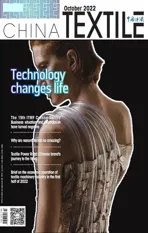Why are nanomaterials so amazing?
2022-11-15ByZhaoXinhua
By Zhao Xinhua
In January 2021,a fire broke out in the apartment where Russian rhythmic gymnast and Olympic cham—pion Daria Valeryevna Shkurikhina lived.But surpris—ingly,Daria's Beijing 2008 Olympic Games gold medal,down to its ribbons,was left almost intact in the fire.The medal ribbon of Beijing 2008 Olympic Games is through high—tech nano treatment,not only waterproof,moth—proof,antifouling,fire,and never fade.
In addition,the nanotechnology was also used in the uniforms for the Beijing Winter Olympic Games.Chinese fashion designers have applied super—heating technology to staff uniforms.One of the new nanomaterials,graphene,can improve the heating efficiency of far—infrared irradiation by emitting far—infrared rays,and the heating effect is more than double the national standard.
Coating a fabric with nanoparticles is being widely applied within the textile industry to improve the performance and functionality of textiles.Nano—technology can add permanent effects and provide high durability fabrics.Coating with nanoparticles can enhance the textiles with antibacterial,water—repel—lant,UV protection,and self—cleaning properties while still maintaining the breathability and tactile proper—ties of the textile.Nano—tex has a range of products using such coatings to resist spills,repel and release stains,and resist static.


Nanoparticles (NPs) are a wide class of ultrafine materials that possess at least one nanoscale dimension(1—100nm).In turns,they exhibit chemical and physical properties that differ significantly from those of their bulk counterparts.Due to their remarkable characteristics,synthesized nanomaterials can be inte—grated into various biomedical and biotechnological applications such as healthcare,food,textile industry,cosmetics,optics,energy science,photocatalysts,and electronics.Recently,the correlation between NPs and the textile industry has taken more atten—tion,especially with the spread of microbial and viral infections.Today,nanomaterials in textiles are of great market value in the manufacture of protective clothing for emergency services such as military per—sonnel,firefighters and medical personnel.
Not only in some professional fields,we also benefit from the application of nanotechnology in everyday clothing.The soup and wine are sprinkled on the clothes,just shake it gently,leaving no traces on the clothes.This kind of clothing uses high—tech 5.0 nanometer technology in the process of spinning into yarn,forming a protective film on the surface of each yarn,so that each yarn has the function of water—repellent and anti—fouling.
Electrospun polymer nanofibers representan ideal class of sensing materials due to their inherently high surface—area—to—volume ratio,small interfibrous pore size,good interconnectivity,surface functionality,superior mechanical performance,low cost,and ease of construction.Electrospun nanofibers have been incorporated into a diversity of detection schemes,including colorimetric,fluorescent,and electrochemi—cal approaches.
To sum up nanotechnology is growing by leaps and bounds and it has been introduced in many fields including the textile industries.There is a considerable potential for profitable appli—cations of nanotechnology in cotton and other textile industries.Its application can economically extend the properties and values of textile processing and products.By deploying nanotechnology,ultra strong,durable and specific function oriented fabrics can be efficiently produced for a number of applications including medi—cal,military and industrial apparels,etc.As mentioned,nano—technology overcomes the limitations of applying conventional methods to impart certain properties to textile materials.There is no doubt that in the next few years,nanotechnology will pen—etrate into every area of textile industry.
杂志排行
China Textile的其它文章
- Sun-protective clothing market expected to reach 95.8 billion yuan in 2026
- Heimtextil Trends 23/24 define the future of home textiles
- Obvious advantages of optical fiber for sensor application
- Phase change materials regulate temperature fluctuations like air conditioners
- Technology changes life
- Smart shape memory materials
